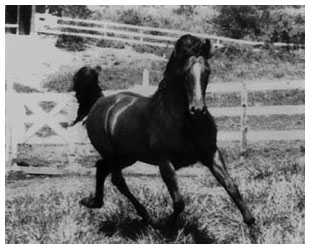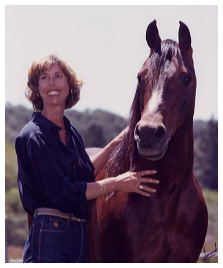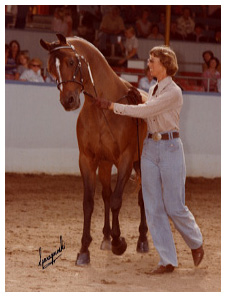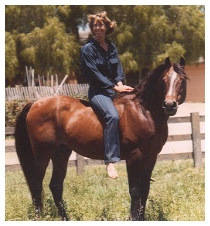
1957 - 1984
For Bay-Abi, life was a lark and he its star merrymaker. All he needed to make his world complete was the perfect sidekick. He found her in 1959 at the first Arabian horse sale to be held at San Francisco's Cow Palace. Her name was Sheila Varian, and she was just 19 years old.
"Bay-Abi turned his head and looked at me with his small, tipped ears and quizzical expression. It was a look I grew to know intimately for the next 25 years of his life," Varian said, recalling the first time she saw the then 2-year-old colt. "Whatever the instinctive connection between the two of us was, I don't know, but if I ever felt the pull towards something, I felt it towards Bay-Abi."
"The bidding commenced and somewhere along the way I looked at my mom (Wenonah Varian) and she nodded and I bid. At $1,000 I could hear Mom murmuring something about 'as high as we could go'...another bid came in at $1,050. Before my mom had a chance to comment, I bid $1,100. It seems as though there was no sound until I heard the words, 'Sold to the blond girl in the front row!' I can't recall a time when I was so incapable of anything as I was in those moments following being told Bay-Abi was mine.
"I would give anything to see the sale agreement today, because one thing I do remember clearly was trying to sign my name with a hand shaking so violently. What an incredible mother and father (Eric Varian) I had to trust a youngster's knowledge and intuition, although I best not give myself too much credit. Don't ever believe my mom didn't do her pedigree research!"
For the next 24 hours, Varian checked on her new horse every 20 minutes only to find he was always laying down, sleeping flat out. "He didn't look sick, but just how long can a horse sleep?" Varian wrote in her memoirs, which she plans, eventually, to publish. "When I took him out of his stall, he played and pranced and I loved everything about him. When I put him away, he lay down and slept like a drugged zombie until I showed up to admire him all over again. Bay-Abi's ability to sleep was a trait that held him in good stead all of his life."
Bay-Abi was the horse who started it all, who launched the incredibly influential Varian Arabians breeding program - a program known around the world for its unique "V" horses, supreme athletes who exhibit breath-taking beauty.
Bred by Lloyd and Mary Silva, of Oregon, Bay-Abi was born on April 22, 1957. His sire, Errabi, was a champion who was killed at age 7. In his pedigree, Errabi carried the lines of "Mirage through Image, Skowronek through Naseem, *Nureddin II through *Ferdin, and the desert bred *Hamrah.
Bay-Abi was his dam's first foal. Angyl, a U.S. Top Ten halter mare, was 10 years old when bred to Errabi. A *Raseyn daughter, Angyl was out of the Polish mare *Wierna, who was by Ofir, and out of Kamea, a Farys daughter. This "melting pot" of bloodlines gave Bay-Abi the best each had to offer, resulting in a superior individual.
Bay-Abi and the tall, slight school teacher formed an incredible bond based on loving devotion and a delicious sense of humor.
Said Varian, "Being lazy by nature, early in our 25 years together, I taught Bay-Abi to come when called. Bay-Abi added his own enthusiasm and soon galloped to me when I called. I did make one small mistake in the training process, however. I insisted that Bay-Abi not only come to me, but come as close as he could physically come without trampling me. He decided galloping to me was the fun part and arrived in a cloud of dust, snorting, bouncing, with his tail over his back, his 15 hands looking like 16. Anyone walking into Bay-Abi's field with me was filled with terror, as the head-throwing stallion charged up, not stopping until he was towering over you."
Varian would put her arms around his neck and Bay-Abi would rest his head on her shoulder, almost sleeping in her arms. Then, Varian would clap her hands, and off he would dash to start over again. Once Bay-Abi was trained to ride, new features were added to the game. Explained Varian, "I'm of the school of riding, not walking. If horses have four legs, and I have two, they should carry me at least half the time. Early on, I taught Bay-Abi to side pass over to the fence when I snapped my fingers so I could hop on from the top rail. You had to jump on his back in a hurry because this train didn't stop long at the station. Down the hill we would roar - fast - with me laying on his back with my fingers laced in his mane." The pair circled the pasture, and if Varian bailed off at the starting point, Bay-Abi would simply circle around again to see if the game could be played once more.
 |
"Bay-Abi was a clown," Varian stated. "He was a very sensitive horse whose good spirits were easily wilted with a slap or yell, although it was easy to re-stimulate him with a voice filled with excitement. It got to be the method of correction that when Bay-Abi was naughty I picked a flower and gave him a gentle little smack with it; he always looked at me like I had just shot him, so I didn't play around with the flower smacking that much. It hurt his feelings." Raised with California ranch horse traditions, Varian chose not to breed Bay-Abi until he was trained. He, therefore, had no foals ready to be shown until he was 7, and he was 10 before his first nationally-competitive performance horses entered the ring. "That is one bit of information I followed for the first and last time," Varian offered. |
|
| Meanwhile, she began showing him at halter. The fashion of the times called for beefy horses, but Varian chose to show Bay-Abi "lean and hard and healthy, to protect his young growing bones from the effects of too much weight." Her decision kept him out of first place, but usually in the ribbons. Nevertheless, he won a championship at the Cow Palace at age 3, qualifying him for the U.S. National Show. |
 |
|
"My childhood years with Sid Spencer (a neighboring rancher and superb horsewoman) taught me to recognize a correct, good-legged, well-balanced horse with all the romantic features the Arabian horse is noted for, even if no one in the Arabian horse world agreed with me. It did bother me a little that Bay-Abi was given so little attention for his many qualities, but what can you do except never admit you noticed and plan your strategy for success." That strategy included a run for the most sought-after award in the Arabian horse industry - the U.S. National Stallion Halter Championship.
To say that Varian ate, drank, smelled, listened, and felt her way to Estes Park, Colorado, in the summer of 1962 would be an understatement. She lived, dreamed and breathed the national championship every moment, both waking and sleeping.
Each day after school she dashed home and worked with Bay-Abi. "The best stallions in the United States would be there," Varian said. "I had watched Paul Polk show the Tones' stallion Fadjur many times, and was always entranced. With Fadjur as my model, I encouraged Bay-Abi to believe he was the handsomest, most beautiful, smartest, happiest horse in the world. He learned this game with the same enthusiasm as he had learned the others. He listened to me saying, 'Happy Boy. Pretty Boy, Bay.' And we would bounce around the barn with Bay-Abi dancing at my side, eyes bright, ears up.
"The stallion class would be large and long, a very taxing class," she continued. "So, I added 'Go to sleep, Bay,' in a soft, melodic tone, and Bay-Abi would drop his head and almost start snoring. He had spent plenty of time tied to a tree when we were through gathering cattle, and he knew well the value of rest.
"So, we rode for conditioning, brushed and curried that shining hide, and each day convinced Bay-Abi he was more wonderful than the day before." Varian and her mother set off for Colorado pulling their old Miley trailer behind the family station wagon. At the national showgrounds, no one took much notice of the unknown girl with the pretty bay stallion. Varian walked much and slept little, studying the other classes, and rehearsing her game plan over and over.
July 4 dawned bright and clear at 7,500 feet above sea level, and 45 of the nation's top stallions entered the ring for a grueling four-hour class. When it was all over, Bay-Abi - showing just as Varian had envisioned - took the crown over such horses as Fadjur, Azrahand, Bolero, Yatez, Gaizon, Murzada, Royal Magic, Sur-Knight, Sur Neet and Saneyn. Varian should have been elated. Instead, she was devastated.
"I was an unknown. The professional trainers were shocked; I saw their faces. We slunk back to the barn positive we had stolen something that didn't belong to us." Gossip said it was a mistake, or that Bay-Abi won only by default, placing third on all three judges' cards. "I believed the gossip," Varian admitted. She did little to promote him, and booked no outside mares to the reigning national champion.
Two years later, Varian showed Bay-Abi to U.S. National Top Ten awards in both English and Western pleasure. Shortly thereafter, at another show, Bill Higgins, who was one of the three judges at Estes Park in 1962, came up to Varian and said, "I loved that bay horse of yours the minute he trotted into the ring. Did you know that Bob Armstrong and Bill Burns (the other two judges) placed him first on their cards as well?
Bay-Abi had won the championship unanimously.
Said Varian, "I slipped back to Bay-Abi's stall and gave deep thought to never again letting others convince me what was and was not quality in my horses." In all, Bay-Abi sired 275 registered Arabians, of which 65 are champions and 24 are national winners. Four were national champions or reserves in halter. Six were national champions in performance. Further, Varian never showed a Bay-Abi horse at the Nationals that didn't win a Top Ten or better award.
"Bay-Abi was a very powerfully strong breeding horse who seemed able to take the best from the mares and make it better. He was a very correct horse and always produced athletes. We were very lucky to have him. He never let me down." To say the least. While he crossed well on a wide variety of bloodlines, Bay-Abi made breeding history when bred to three special Polish mares - mares who would establish the fertile fields from which more than seven generations of Varian Arabians would flourish. Varians imported the trio in 1961 with the assistance of Englishwoman Patricia Lindsay.
It is painful for Varian to recall the year 1984. "The last of my family passed away, or so it seemed to me," she said at a 1990 presentation. "Ronteza died at age 28. She had raised me. Now I could see the inevitable happening. My wonderful mares and Bay-Abi were getting old. They made it to old age, bless their hearts, but it was a terrible year.... the loss of *Ostroga at 28, *Bachantka at 27, and the start of my program, Bay-Abi, at 27. All my roots, it seemed, were gone. Marnie Sperry cried with me, and Don (Severa) whispered in my ear, trying to cheer me up, 'They can knock us down, Sheila, but they can't eat us.' It was very difficult."
On a lighter note, Varian also recalled: "The most fun etched in my memory - probably because Bay-Abi and I did it together for a lot of years - was the daily teasing ritual we had. Our ranch is up and down and quite spread out, so I've never walked if there was a horse to ride. Consequently, for most of Bay-Abi's life, I teased the mares for breeding on him bareback, out in the pastures."
 "We raced from pasture to pasture, sliding into the gates. Bay-Abi would give me so many seconds to bend over and get the latch unhooked. He would side-pass through, slip around the end of the gate and side-pass back for me to close it, faster than you could say 'Boo' Then, as soon as I had the gate closed, off we would dash again. When we got to the mares (who were used to this daily occurrence of a bay express train with flying mane and tail with a girl on his back singing at the top of her lungs, racing up to them), Bay-Abi would be all business, walking through the mares, determining who was in heat, coming in, going out. When we would finish one group, we would whiz off to the next pasture, often with funny crow-hops thrown in for good measure."
"We raced from pasture to pasture, sliding into the gates. Bay-Abi would give me so many seconds to bend over and get the latch unhooked. He would side-pass through, slip around the end of the gate and side-pass back for me to close it, faster than you could say 'Boo' Then, as soon as I had the gate closed, off we would dash again. When we got to the mares (who were used to this daily occurrence of a bay express train with flying mane and tail with a girl on his back singing at the top of her lungs, racing up to them), Bay-Abi would be all business, walking through the mares, determining who was in heat, coming in, going out. When we would finish one group, we would whiz off to the next pasture, often with funny crow-hops thrown in for good measure."
Today, Varian has only to gaze out over her pastures or scan the pages of popular breed journals to see the boundless beauty resulting from her labor - years of joys and sorrows, dreams and memories woven into equine masterpieces which preen and prance across four continents.
And, if one looks close enough, one can almost see Bay-Abi's puckish spirit dancing close behind - ears pricked, gay tail over his back, and mischief twinkling in his eyes.








